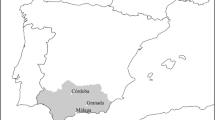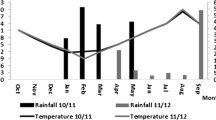Abstract
We analysed the occurrence of the Echium pollen in the atmosphere of Salamanca, on the basis of 8-year observation (2000–2007) with the aim to evaluate its aerobiological behaviour. Aerobiological samples were collected by the Hirst volumetric method with a 7-day Burkard spore trap. The atmospheric pollen season of Echium was observed in late spring (May and June), showing also high levels in midday hours. However, an anomalous flowering period was detected in late autumn and early winter between years 2006 and 2007 and it could be connected with high daily temperature registered in October 2006 in comparison with the 2000–2005 period and its particular increasing tendency similar to those detected in the preceding month of the late spring flowering period. Statistical analysis by means of the Spearman’s non-parametrical test and linear regression analysis reflected a positive correlation with temperature and a trend to increase in daily temperature during late October 2006 and April in 2000–2005 with similar indexes (R 2 = 0.50, R 2 = 0.58, respectively). In conclusion, aerobiological data could contribute to the development of further studies in order to a better understanding of different plant species phenology.




Similar content being viewed by others
References
Alba, F., Díaz de la Guardia, C., & Comtois, P. (2000). The effect of meteorological parameters on diurnal patterns of airborne olive pollen concentration. Grana, 39, 200–208.
Andersen, T. B. (1991). A model to predict the beginning of the pollen season. Grana, 30, 269–275.
Capel Molina, J. J. (1981). Los climas de España. Barcelona: Oikos-Tau.
Celenk, S., & Bicakci, A. (2005). Aerobiological investigation in Bitlis, Turkey. Annals of Agricultural and Environmental Medicine, 12, 87–93.
Chuine, I., Cour, P., & Rousseau, D. (1999). Selecting models to predict the timing of flowering of temperate trees: implications for tree phenology modelling. Plant, Cell and Environment, 22, 1–13.
Fitter, A. H., Fitter, R. S. R., Harris, I. T. B., & Williamson, M. H. (1995). Relationships between first flowering date and temperature in the flora of a locality in central England. Functional Ecology, 9, 55–60.
Fuertes-Rodríguez, C. R., González-Parrado, Z., Vega-Maray, A. M., Valencia-Barrera, R. M., & Fernández-González, D. (2007). Effect of air temperature on forecasting the start of Cupressaceae pollen type in Ponferrada (León. Spain). Annals of Agricultural and Environmental Medicine, 14, 237–242.
Galán, C., Cariñanos, P., Alcázar, P., & Domínguez, E. (2007). Spanish Aerobiology Network (REA): Management and quality manual. Córdoba: Servicio de Publicaciones de la Universidad de Córdoba.
Galán, C., Tormo, R., Cuevas, J., Infante, F., & Domínguez, E. (1991). Theoretical daily variation patterns of airborne pollen in the South-West of Spain. Grana, 30, 201–209.
García-Mozo, H., Domínguez-Vilches, E., & Galán, C. (2007). Airborne allergenic pollen in natural areas: Hornachuelos Natural Park, Córdoba, Southern Spain. Annals of Agricultural and Environmental Medicine, 14, 63–69.
García-Mozo, H., Galán, C., Belmonte, J., Bermejo, D., Candau, P., Díaz de la Guardia, C., et al. (2009). Predicting the start and peak dates of the Poaceae pollen season in Spain using process-based models. Agricultural and Forest Meteorology, 149, 256–262.
González Minero, F. J., Candau, P., Morales, J., & Tomás, C. (1998). A study of non-arboreal pollen collected during ten consecutive years in the air of the SW Spain. Effect drought period on pollen spectrum. Grana, 37, 367–373.
Gutiérrez Bustillo, M., Cervigón Morales, P., & Pertiñez Izquierdo, C. (2002). Aerobiología en Madrid: Estación de Ciudad Universitaria (2000–2001). Rea, 7, 225–230.
Jato, V., Rodríguez-Rajo, F. J., Alcázar, P., De Nuntiis, P., Galán, C., & Mandrioli, P. (2006). May the definition of pollen season influence aerobiological results? Aerobiologia, 22, 13–25.
Jong, N. W., Vermeulen, A. M., Gerth van Wijk, R., & de Groot, H. (1998). Occupational allergy caused by flowers. Allergy, 53, 204–209.
Katelaris, C., Baldo, B. A., Howden, M. E., Matthews, P. A., & Walls, R. A. (1982). Investigation of the involvement of Echium plantagineum (Paterson’s Curse) in seasonal allergy. IgE antibodies to Echium and other weed pollens. Allergy, 37, 21–29.
Latorre, F., & Pérez, C. F. (1997). One year of airborne pollen sampling in Mar del Plata (Argentina). Grana, 36, 49–53.
Matthews, P. A., Baldo, B. A., & Howden, M. E. (1988). Cytochrome c allergens isolated from the pollens of the dicotyledons English plantain (Plantago lanceolata) and Paterson’s Curse (Echium plantagineum). Molecular Immunology, 25, 63–71.
Menzel, A. (2002). Phenology: Its importance to global change community. Climate Change, 54, 379–385.
Muñoz, R. A. F., Molina, R. T., Palacios, I. S., Corchero, A. M., & Muñoz, J. T. (2005). Airborne behaviour of Echium pollen. Aerobiologia, 21, 125–130.
Paulino, R., Tormo, R., Silva, I., & Muñoz, A. F. (2002). Aerobiología en Extremadura: Estación de Cáceres (2000–2001). Rea, 7, 177–182.
Peeters, A. G. (1998). Cumulative temperature for prediction of the beginning of ash (Fraxinus excelsior L.) pollen season. Aerobiologia, 14, 375–381.
Ribeiro, H., Cunha, M., & Abreu, I. (2008). Quantitative forecasting of olive yield in Northern Portugal using a bioclimatic model. Aerobiologia, 24, 141–150.
Rivas Martínez, S., Díaz, T. E., Fernández-González, F., Izco, J., Loidi, J., Lousã, M., et al. (2002). Vascular plant communities of Spain and Portugal. Addenda to the syntaxonomical checklist of 2001. Part I. Itinera Geobotanica, 15, 5–432.
Ruiz García, L., Díaz de la Guardia, C., & Mota, J. F. (1998). Analysis of airborne pollen in the town of Almería (South-East Spain), 1995–1996. Aerobiologia, 14, 281–284.
Sáenz Laín, C., & Gómez Ferreras, C. (2000). Mieles españolas. Características e identificación mediante el análisis de polen. Madrid: Mundi-Prensa.
Salvador de Luna, J. V., & Sánchez Sánchez, J. (1990). Polen de plantas entomófilas en la atmósfera de Valladolid. In G. Blanca, C. Díaz, M. C. Fernández, M. Garrido, M. I. Rodríguez, & A. T. Romero (Eds.), Polen, esporas y sus aplicaciones. VII Simposio de Palinología (pp. 363–368). Granada: Universidad de Granada.
Schwartz, H. J. (2003). Phenology: An integrative environmental science. Dordrecht: Kluwer.
Silva, I., Muñoz, A. F., & Tormo, R. (1998). Aerobiología en Extremadura: Estación de Badajoz (1997). Rea, 4, 95–98.
Subiza, J., Jerez, M., Jiménez, J. A., Narganes, M. J., Cabrera, M., Varela, S., et al. (1995). Allergenic pollen and pollinosis in Madrid. Journal of Allergy and Clinical Immunology, 96, 15–23.
Tavira Muñoz, J., Tormo Molina, R., Muñoz Rodríguez, A. F., Silva Palacios, I., & Gonzalo Garijo, M. A. (1998). Calendario polínico de la ciudad de Cáceres. Revista Española de Alergología e Inmunología Clínica, 13, 288–293.
Trigo, M. M., Jato, M. V., Fernández, D., & Galán, C. (2008). Atlas aeropalinológico de España. León: Universidad de León.
Trigo, M. M., Recio, M., Toro, F. J., & Cabezudo, B. (1998). Aerobiología en Andalucía: Estación de Málaga (1995–1996). Rea, 3, 33–36.
Vega-Maray, A. M., Valencia-Barrera, R. M., Fernández-González, D., & Fraile, R. (2003). Urticaceae pollen concentration in the atmosphere of North Western Spain. Annals of Agricultural and Environmental Medicine, 10, 249–255.
Acknowledgments
This study was partially supported by the Public Health Council of Junta de Castilla y León, agreement code H42. We are grateful to the Inmunoallergic Services of Salamanca University Hospital for kindly providing us with different slide preparations. We also thank anonymous reviewers for their useful comments which have improved the manuscript. The first author would like to thank the University of Salamanca for his research grant.
Author information
Authors and Affiliations
Corresponding author
Rights and permissions
About this article
Cite this article
Rodríguez de la Cruz, D., Sánchez-Reyes, E. & Sánchez-Sánchez, J. Incidence of Echium pollen in the Middle West of Iberian Peninsula: an unusual flowering period and its significance in aerobiological studies. Aerobiologia 28, 317–323 (2012). https://doi.org/10.1007/s10453-011-9236-9
Received:
Accepted:
Published:
Issue Date:
DOI: https://doi.org/10.1007/s10453-011-9236-9




